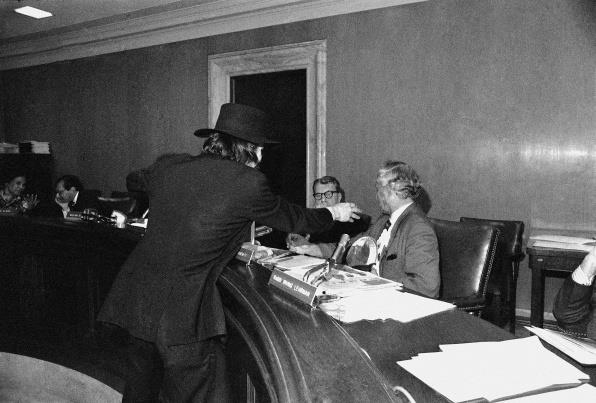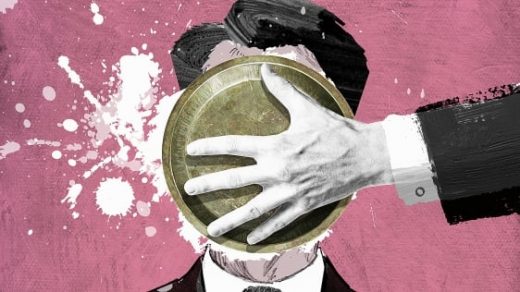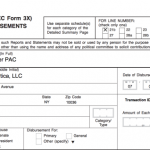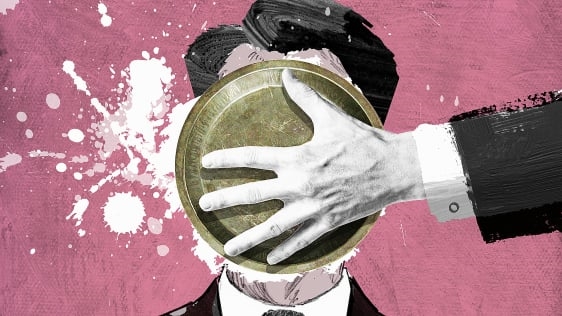How Pie Became A Powerful Punchline In Political Provocation
When Sean Thompson showed up at a farm-to-table dinner at Sacramento Charter High School in September of 2016, he was there to serve up some just desserts to Mayor Kevin Johnson.
Thompson, a 32-year-old veteran who’d suffered bouts of homelessness since the recession, felt the mayor hadn’t done enough to prioritize the needs of the city’s poor and homeless during his two terms in office, so he’d plotted a Three Stooges-style comeuppance. “I wanted to get people’s attention and embarrass him,” he says, adding that as a nonviolent activist, he takes issue with the idea that anything was technically “thrown.” “He turned around and I just–as mellow as anyone could–pushed pie into his face.”

[Photo: Philippe Calouro Ngabonziza]
Johnson, an ex-NBA all-star who led a scandal-plagued administration, was far from amused. In fact, he knocked Thompson down and then beat him so badly that Thompson required nine stitches around his left eye socket. That wasn’t the end of the punishment, though, as the city of Sacramento then charged Thompson with what his attorney Claire White believes may be the stiffest potential penalty a pie-thrower has ever received: felony assault and misdemeanor battery, with bail set at $100,000.
Among protestors, the term d’art for Thompson’s actions is to stage a “pastry uprising”: Over the last several decades, pie-throwers have targeted all manner of government and business leaders for perceived slights in their worldviews and actions. The hit list includes Watergate perpetrator G. Gordon Liddy in 1977, hydrogen bomb inventor Edward Teller in 1980 and Monsanto’s CEO Robert Shapiro in 1998. World Trade Organization head Renato Ruggiero was also hit in 1998, followed by Microsoft’s Bill Gates in 1999.
More recently, Calvin Klein got tagged in 2001, the Green Party’s Ralph Nader in 2003, and conservative icon Ann Coulter in 2004, along with Vermont governor James Douglas in 2008, and Michigan Senator Carl Levin in 2010. In May, the CEO of Qantas airline was pied while speaking out for a gay marriage vote in Australia.
According to Pie Any Means Necessary, an activist handbook printed more than a decade ago, the record of political pieing dates back at least to Spain in the mid-1600s, when a band of bakers snuck into a royal dinner to toss pies at a leader of the Hapsburg Monarchy, protesting policies of heavy taxation and military conscription. It’s since become a staple slapstick gag in films and an accessible way for anyone with an oven to protest.
From a strategic standpoint, pelting someone with a non-lethal, somewhat fluffy object makes sense: baked goods do less damage than bullets. But as Monty Python explains in their “History of the Joke” sketch, which takes the form of a mock lecture that involves increasingly messy demonstrations, there’s an especially “ribald connotation associated with the dispatch of an edible missile.” Pie is goopy, a treat, and meant to be served in moderation. When weaponized, it becomes a comedic way to exert power over someone–you just gave them too much of a good thing, in a way they can’t control–making it clear that not everyone takes that person or their agenda so seriously.
Despite the vicious end result, White, Thompson’s defense attorney, says that the pie might have been a good option in our charged political times. “In an era where people are so on edge about violence in the movement for resistance, hopefully, they’ll look at some whip cream in the face as a reasonable alternative,” she says.

[Photo: AP Photo/Henry Griffin]
Taking “pie-rect” action
Protestors have chucked eggs and tomatoes at powerful people since at least early European times, but in the U.S. the recipe for sweets-as-salvos was inspired by early slapstick films. In 1970, Tom Forcade, the head of the Underground Press Syndicate, a coalition of alternative newspapers, appeared before the President’s Commission on Obscenity and Pornography, which was investigating whether people’s ability to view potentially offensive or sexually explicit material might lead to criminal behavior.
The hearings hinged on a Supreme Court verdict a year earlier, which upheld privacy rights in the home. At that same time, alternative newspapers nationwide were often shut down or sanctioned for printing various forms of lewd content. According to The Paris Review, Forcade testified against the double standard. A New York Times reporter then recorded that Forcade told the commission that the entire proceeding was a “Keystone Kommittee engaged in a blatant McCarthyesque witch hunt.”
In comic parlance, this is called a set-up: Forcade’s Keystone reference paid homage to “Keystone Kops,” a silent film era comedy about a bungling set of policemen that often featured pie throwing among the high jinx. When the committee’s commissioner, sociology professor Otto Larsen, asked Forcade for clarification, Forcade delivered his punchline, approaching the panel to throw a pie into Larsen’s face, and then “exclaiming ‘pie power’ as the solution to pompousness,” according to the Times story. (The projectile was unappetizingly described as “wet” and “cheese” of some sort.)
Over the next three decades, protesters followed that lead, pieing dozens of targets around the country. At one point, a semi-formal company called Pie Kill Unlimited popped up in New York, posting want ads that offered to pie anyone, political or not, which led some strange takedowns, including William Shatner at a Star Trek convention.
Starting in 1997, a San Francisco group called the Biotic Baking Brigade (BBB)–which was fighting globalization, industrial deregulation, and biotech–pied everyone from economist Milton Friedman to Monsanto’s Shapiro. After all, it was San Francisco, the protest capital of the country, where sit-ins and marches seemed so common that they often didn’t always garner media attention. “We can hold rallies ’til we turn blue in the proverbial face, and the media doesn’t care,” Justin Gross, one of the BBB members told Mother Jones at the time.
Hitting someone with a pie in the face, however, worked differently: As in those early comedies, each hit became a surreal must-share moment for news agencies. Pieing became an early political meme. Activists made sure to videotape or take pictures of each delivery, which with the growing reach of the internet were easily passed along to embolden others. Other pie activists overseas followed the action, and also took up baked goods.
In Geneva in 1998, the London-based crew People Insurgent Everywhere (yes, PIE) hit World Trade Organization director Renato Ruggiero for defending a decision that overturned protection against endangered sea turtles. Video of the Ruggiero incident shows that he took the hit, then turned and strode calmly to a nearby men’s room to wipe off. “When they have no more rational arguments, the fringe elements have to use cake,” he later told the press, mistaking the type of confection that had been recently smeared on his face.
A year later in Brussels, a self-proclaimed “entarteur” named Noel Godin coordinated with over 30 members of his International Patisserie Brigade to cream Bill Gates for not doing imaginative enough things with his wealth (this was before the founding of the Gates Foundation). Gates was hit with several pies at once, but declined to address anything substantive besides the quality of the projectiles. “The pie wasn’t even that good,” he reportedly told a fellow Mircosoft employee directly afterward.
There may be merit in his critique: Gates was hit with a cream pie. Per the BBB handbook, the common recipe for tofu cream pie, which has been used many times over, consists of a graham cracker and maple syrup crust with a full pound of blended silken tofu filling, along a little Sucanat (natural cane sugar), almond butter and lemon juice and zest. “It’s super yummy and gets the job done!”—adds an emphatic side note typed into the cooking instructions. (Here’s the exact recipe, plus a variation using cornstarch and soy milk to make cheesecake).

[Image: courtesy Pie Any Means Necessary]
In the late-90s, as pie-ings picked up, the British grocery chain Tesco conducted its own threat-level assessment of its different pie varieties to make sure the goods they sold wouldn’t hurt anyone. The results were encouraging. “A spokesman later said egg custard tarts had proved the best for throwing, because they were deep and large, while lemon meringue pies held together well during flight,” the BBC News reported.
During this time, the BBB recorded at least 202 hits by activists–targeting anyone from Roy Rogers to Kenny Rogers, Sylvester Stallone, and Andy Warhol–as other groups like PETA picked up and popularized the tactic. (At one point, PETA struck an actor playing Ronald McDonald five times, a record for the most hits against one person–or persona.)
When apprehended, most pie throwers were usually charged with harassment and issued a small fine, says Aron “Pieman” Kay, one of the era’s most active throwers and a former member of Pie Kill. Agent Apple, the leader of San Francisco’s BBB, who still insists on using his code-name only, says the tradition of silent film pie tosses by Soupy Sales, the Three Stooges, and the Marx Brothers, made him believe the practice was, while not always tasteful, at least socially accepted. “It really inspired me just to think, well, if the people pie, the leaders will swallow,” he says.
Avoiding Serious Heat
Before Thompson, the great moment in court for pies was in November 1998, when the BBB targeted San Francisco Mayor Willie Brown but overlooked some issues with its ammo. Much like Thompson’s action against Johnson, the BBB wanted to hit Brown to protest against the city leader’s apathetic stance toward resolving homelessness. Except their pies got overcooked; so three operatives went with store-bought instead.
At least one of those was cherry. Only after it was thrown did the squad realize that the filling looked like blood, which incited panic from a crowd. Security tackled one of the throwers, a 27-year-old named Rahula Janowski (code name: Agent Lemon Meringue) and broke her collarbone. The other two activists were detained and arrested.
The so-called “Cherry Pie Three” eventually served six months for misdemeanor battery, a sentence that seemed harsh for a liberal hotbed like San Francisco. When Procter & Gamble chairman John Pepper was hit by an animal rights activist in Columbus Ohio several months before the Brown debacle, the assailant had bail set at $500, but then avoided charges altogether.
Janowski thinks the penalty may have had to do with the fact that San Francisco still had memories of mayor George Moscone and supervisor Harvey Milk’s assassinations while in office. And some activists felt that three white people trying to diminish a prominent black figure didn’t look great either.
In 2000, activists targeted Dan Glickman, President Clinton’s Secretary of Agriculture for promoting meat consumption, and George Ryan, the governor of Illinois for not doing enough for education while anti-fur advocates from PETA nailed Michael Kors at a New York fashion event, an act they repeated on Calvin Klein mid-2001. But after 9/11, Janowski, Kay, and Agent Apple all say that it seemed like the movement’s bravery faltered because America’s sense of humor all but disappeared; everyone was on the hunt for domestic terrorists. Pranksters didn’t want to get caught in the crossfire–as Thompson’s charges make clear.
In fact, Janowski says she’s stopped all “public pie activities” and become a conflict mediator. Kay’s done too. “I’m not the fastest runner anymore,” he says. Agent Apple quit to work in the sustainable design field, briefly unretiring to plan his own pie-ing as part of a presentation about the enduring importance of the art that he gave overseas. He says that being on the receiving end felt “delicious.”

[Photo: Stan Honda/PA Images/PA Images/Getty Images]
Judging The Impact
After Sean Thompson pied Kevin Johnson, the Sacramento District Attorney’s office charged him with felony assault and misdemeanor battery. Because the incident involved a public official, he could have been sentenced to up to four years in jail on the most serious charge. Thompson’s defense team countered that the incident wasn’t assault or battery but an act of political theater. The difference is that while those crimes are defined by “harmful and/or offensive touching,” political theater is often participatory, unpolished, and has a long tradition of physical contact with the audience.
“This was a real genuine version of street theater,” White says, noting that Thompson had purchased a prop (the pie) and scripted his plan. Upon delivery, he stated: “You need to do a better job representing your people.”
Like any performer, Thompson claims he was also nervous before the show: He’d bought a coconut cream pie that looked fluffy, soft, and especially “delicious” just in case he couldn’t go through with it. “I love coconut cream pie. I could get fat on the stuff,” he says.
Given the fact that one of the two people involved felt the pie throwing was theater of such poor quality that it required a violent response, it helps to consider about exactly why throwing pie is funny and transgressive in the first place. Peter McGraw is a marketing and psychology professor at the Humor Research Lab at the University of Colorado Boulder and co-creator of something called the Benign Violation Theory, which does the very unfunny work of explaining why sometimes immoral behavior seems funny.
In McGraw’s taxonomy, most everyday comments or actions can be considered either tame (benign) or inappropriate (a violation). Most jokes are actions done to make something inappropriate acceptable and therefore funny: a benign violation. “For something to be funny in the eyes of the audience, the situation needs to be wrong yet okay, threatening yet safe. It needs to not make sense, yet make sense,” McGraw says.
Political pie throwing accomplishes that as simple slapstick, but goes further because it’s also satire, an “act of punching up” against a higher status person. Historically, that was typical of some silent films, according to a report entitled “A Pie in the Face” by Donald Morlan, a communications professor and comedy film historian at the University of Dayton in Ohio, who has documented the antics of the Three Stooges. “Low-life ruffians were thrust into high-society settings and quickly made a shambles of the elitist climate,” Morlan writes in an except shared by the New York Times in the mid-90s. “The result in each case was the same–society matrons and patrons were quickly relegated to the level of the ruffians and made to look foolish,” which downplayed the importance of wealth and aristocracy during the depression.
When deployed more strategically, this approach has been given a semi-serious name. It’s dubbed “laughtivism” a form of nonviolent resistance that presents “an element of creative dilemma,” says Srdja Popovic, a former organizer with Serbia’s Optor movement, which used carefully designed schticks through the ’90s to encourage the dissent against dictator Slobodan Milosevic.
“Laughtivism is not a political satire,” Popovic says. “It’s an intentional thing to make your opponent be put between a rock and a hard place. If they react they will look stupid. If they don’t react, they will look weak and people will start replicating the tactics.” In Serbia, for instance, one early bit involved painting the unpopular leader’s face on an oil barrel, which was placed in a public area alongside a baseball bat and sign advertising the chance to smash his face in effigy. (So many people did it, that cops had to “arrest” the barrel to stop the scene, an incident that was photographed and reprinted in newspapers.)
In Popovic’s view, that’s a great way to battle fear and apathy. “[When] you’re doing the funny actions, the people tend to be less tense and more enthusiastic, which is one of the goals of the nonviolent movement.”
Today, Popovic helps run the nonprofit Center for Applied Nonviolent Action and Strategies, which he cofounded in 2004 to teach pro-democracy and human rights groups organizing theories, tactics, and how to create symbolic public acts that might counter oppressive regimes. The organization has since worked with groups in at least 50 countries, and created free manuals for action.
He’s also “not a particular fan” of pie throwing for two reasons. The best nonviolent acts are low risk, so they can be repeated by others to build momentum. In Finland, for instance, where militaristic white nationalists have formed anti-immigrant neighborhood patrols, activists now dress like clowns and join them. The resulting spectacle makes something that could otherwise be intimidating look ridiculous. As Thompson proved, pie throwing can carry physical and legal repercussions, making it hard to keep up the action.
And a good guffaw shouldn’t alienate any potential supporters. “[Pie throwing] can be funny, but it also can be offensive and insulting and people can take it differently,” Popovic says.

[Photo: Getty Images]
Baking A Strong Defense
Mayor Johnson certainly took it differently. When the case went to trial earlier this summer, though, enough of the jury had different interpretations to be unable to render a verdict, ending the case with a hung jury. In September 2017, about a year after the incident, Thompson pled no contest to disturbing the peace, and walked with no probation. (People have a hard time agreeing on what’s funny, says McGraw. “That’s the beautiful thing about juries. You need unanimity [to convict].”)
As the trial progressed, Thompson found that the pie had created something beyond a viral news clip. While out on bail, he showed up to a city council meeting to share more of his feelings on homelessness. News crews turned up to watch him. So did more activists, who wanted to share their support for Thompson and his cause with yellow T-shirts that read “The People’s Pie” above an image of an extra-large coconut cream. His act had become a meme. “Ultimately, it went the best way I could have imagined, minus the stitches,” he says.
Since Sacramento Mayor Darrell Steinberg took office in December 2016, he appears to have taken the homelessness issue more seriously than Johnson. Earlier this year, the city council approved a housing and voucher program that’s projected to reach around 1,750 people over the next three years. It also approved a plan to take part in a $64 million state pilot program to provide a holistic network of support services capable of reaching about 3,000 people in need.
Thompson, who is currently a self-employed roofer and carpenter, still isn’t convinced. After attending a couple of city council meetings this year, he feels like the local government can’t relate to working-class problems and concerns. At the same time, he’s reverted to challenging authority with more traditional tactics like marching, and waving protest signs, which is accompanied by a long-term plan to “enact change from within the system.” In 2018, he expects to begin working toward a political science degree, which might one day allow him to hold higher office.
“What’s really important to me has always been [making] change, and I never really took time to determine how my activism is effecting change,” he says. Right now, that means keeping his beloved treat on the table. Thompson may not throw pie again, but he’s bringing at least one of his now signature coconut creams to a gathering of family and friends this Thanksgiving. “It’s sort of a running gimmick.”
Fast Company , Read Full Story
(69)














